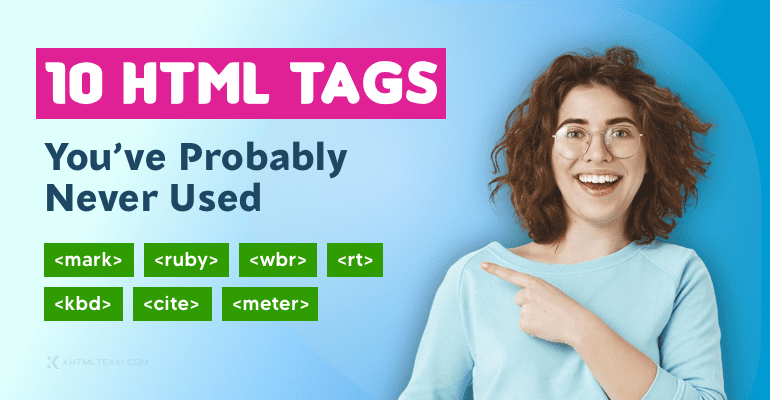HTML is a constantly evolving language, and developers often rely on a set of core tags for structuring web pages. However, there are several lesser-known HTML tags that can significantly improve your website’s functionality, accessibility, and design. In this article, we’ll explore 10 HTML tags that you might not have used yet, along with code examples to help you get started.
1. <details> and <summary>
The <details> element is used to create a disclosure widget that allows users to toggle between hiding and showing additional content. This is useful for FAQs or content that doesn’t need to be visible all the time.
The <summary> tag is used as a clickable heading within the <details> element.
Example:
<details> <summary>Click to see more details</summary> <p>This is additional information that can be toggled.</p> </details>
2. <mark>
The <mark> tag is used to highlight parts of the text that are relevant or important. This tag is commonly used for search result highlighting or marking changes in documents.
Example:
<p>Learn about <mark>HTML</mark> tags in this article.</p>
3. <progress>
The <progress> element is used to represent the completion of a task in HTML. This is commonly used for progress bars in file uploads, downloads, or form submissions.
Example:
<progress value="70" max="100">70%</progress>
4. <meter>
The <meter> tag is used to display a scalar value within a range. This can be used for showing data like a battery level, temperature, or a rating scale.
Example:
<meter value="0.6" min="0" max="1">60%</meter>
5. <time>
The <time> tag is used to represent a specific period in time. It can be used for dates, times, or durations, and helps search engines understand time-related content better.
Example:
<p>The event starts on <time datetime="2025-05-01">May 1, 2025</time>.</p>
6. <ruby>, <rt>, and <rp>
The <ruby> element is used for marking up East Asian typography, such as annotations for kanji characters in Japanese. The <rt> element is used to specify the pronunciation of the text, and <rp> is used to add fallback parentheses in browsers that don’t support ruby annotations.
Example:
<ruby> 漢 <rt>kan</rt> 字 <rt>ji</rt> </ruby>
7. <wbr>
The <wbr> tag is used to specify an optional line break within text. This is useful when you want to suggest a potential break point without forcing it, especially for long words or URLs.
Example:
<p>Here is a longwordwithno< wbr>breakpoints.</p>
8. <kbd>
The <kbd> tag represents user input, such as keyboard commands. This is typically used to show specific keys pressed by the user.
Example:
<p>To copy the text, press <kbd>Ctrl</kbd> + <kbd>C</kbd>.</p>
9. <cite>
The <cite> tag is used to reference the title of a creative work, such as a book, movie, or website. It helps improve the semantic meaning of your content.
Example:
<p>According to <cite>The Art of HTML</cite>, HTML tags are essential for structuring web pages.</p>
10. <output>
The <output> tag is used to represent the result of a calculation or user action. It’s commonly used with forms and scripts to display results dynamically.
Example:
<form oninput="result.value=parseInt(a.value)+parseInt(b.value)"> <input type="number" id="a"> + <input type="number" id="b"> = <output name="result" for="a b">0</output> </form>
Conclusion
These 10 HTML tags may not be as widely known or used as others, but they can enhance your website’s functionality and accessibility. Whether you are adding interactive elements like the <details> and <summary> tags or improving accessibility with the <time> and <ruby> tags, mastering these elements can make your HTML code cleaner and more semantic.
By incorporating these lesser-known HTML tags into your web development projects, you’ll be able to create more dynamic, accessible, and feature-rich websites.
XHTMLTEAM is a leading web development company that specializes in converting designs into clean, high-quality HTML, CSS, and WordPress code. With a team of experienced developers, XHTMLTEAM ensures that your website is not only functional but also optimized for performance and accessibility. Whether you’re looking to convert Figma to HTML, integrate advanced HTML tags, or need a custom WordPress solution, XHTMLTEAM provides expert services to meet your needs. Our focus on precision, quality, and industry best practices makes us the ideal partner for web development projects. If you’re looking for seamless conversion, fast delivery, and exceptional service, XHTMLTEAM is your go-to choice.
Keywords: XHTMLTEAM, convert Figma to HTML, HTML tags, WordPress solutions, web development company, HTML, CSS, custom WordPress, expert web development services, precision web development, seamless conversion, fast delivery, high-quality HTML code.

